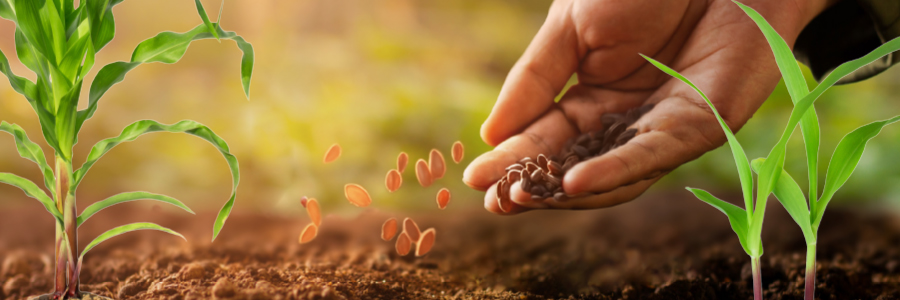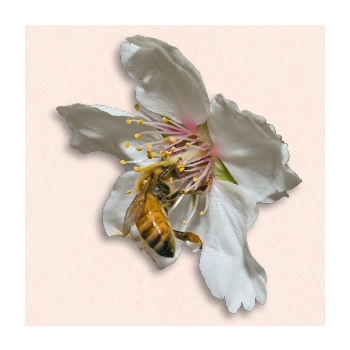
The “biodiversity deserts” of modern agriculture10
Agriculture is a primary driver of biodiversity loss and the most significant threat to more than 85 percent of species at greatest risk for extinction.11 12 Just four crops—wheat, rice, corn, and soybeans—consume 50 percent of the world's farmland.13 They’re often grown in monocultures, which dominate 80 percent of cultivated agricultural land, dedicating thousands of acres to producing a single crop reliant on chemical fertilizers and pesticides.14 15 16 These practices destroy habitats and biodiversity, and studies show they also degrade soil health, disrupting the balance of bacterial and fungal communities.17 18 Additionally, monocultures and modern seed breeding practices, which demand uniformity for every new generation of seeds, erode genetic adaptability, leaving crops more vulnerable to pests and diseases.19 20
The foundational principle of regenerative agriculture is to support biodiversity above and below ground21 22
All truly regenerative systems promote biodiversity through interdependent practices.23 In return, diverse species provide essential ecosystem services, including nutrient cycling, erosion control, carbon sequestration, water infiltration, and pest and disease regulation.24 25
Biodiversity-cultivating practices include:
- Protecting soil biology by reducing or eliminating tillage and synthetic pesticides and fertilizers.26 27
- Promoting soil biological diversity and enhancing fertility with compost and mulch.28 29
- Providing a range of nutrients, root structures, and genetic adaptability through continuous cultivation of diversified cover crops and crop rotations.30 31
- Encouraging pollinators and beneficial predators by creating on-farm habitats and protecting wild habitats.32 33
- Generating efficient, biologically diverse fertilizer on-farm by incorporating grazing ruminants. Grazing also promotes new plant growth and turnover of plant roots, feeding soil microbes and enhancing carbon sequestration.34 35 36
Returning to the California almond orchards we’ve visited before in this series, we find the research backs up positive outcomes for biodiversity in regenerative systems. This 2021 study, comparing conventional and regeneratively managed orchards, found more biodiversity in regenerative orchards across multiple metrics, including:37
- Higher microbial biomass, including Actinobacteria, whose presence is strongly correlated with soil carbon increases.38
- Significantly higher and more diverse invertebrate abundance; for example, earthworms averaged 24.7 per square meter compared to 4.92 in conventional.39
- Regenerative orchard floors averaged 75-100 percent plant cover and seven species, while conventional averaged 0-25 percent and two species.40
Conventional operations relied on synthetic herbicides and insecticides, while regenerative depended on the diversity and abundance of plant cover and invertebrate communities for pest control. Yet, there was no difference in pest damage between the orchards!41
Biodiversity on the farm
 "It's all about biodiversity" for Greg Massa and Raquel Krach of California's Massa Organics, which they cultivate through practices including no-till, cover crops, and beneficial insect habitats. Their orchard doesn’t suffer from pest outbreaks because natural predators keep it in balance. Greg has also documented 220 bird species on their land so far!42
"It's all about biodiversity" for Greg Massa and Raquel Krach of California's Massa Organics, which they cultivate through practices including no-till, cover crops, and beneficial insect habitats. Their orchard doesn’t suffer from pest outbreaks because natural predators keep it in balance. Greg has also documented 220 bird species on their land so far!42
At White Oak Pastures in Georgia, complementary animal species are pastured side-by-side. Cows graze the grass, goats and sheep take care of weeds, a variety of poultry feed on roots, bugs, and grubs, and all species fertilize the soil. In 2017, White Oaks sequestered 919 tons of CO2 in the soil, and their beef’s carbon footprint was 111 percent lower than that of conventional!43
To restore and maintain the biodiversity our planet requires for survival, we must see its footprint on our menus. Choosing food produced in a way that doesn’t externalize its cost onto the planet can't be dismissed as a concept for elitists and idealists—because it's a choice whose toll we all will pay.
References
- “Why Soil Biodiversity.” Global Soil Biodiversity Initiative, www.globalsoilbiodiversity.org/why-soil-biodiversity. Accessed 22 Feb. 2024.
- Thomson, Ashley, et al. “Biodiversity and the Amazon Rainforest.” Greenpeace USA - We Fight for a Greener, More Peaceful World., 2 June 2022, www.greenpeace.org/usa/biodiversity-and-the-amazon-rainforest/.
- Moncel, Bethany. “Why Cilantro Tastes like Soap to Some People.” The Spruce Eats, The Spruce Eats, 17 Sept. 2020, www.thespruceeats.com/why-does-cilantro-taste-soapy-1328523.
- “Biodiversity.” Rodale Institute, 2 Nov. 2018, rodaleinstitute.org/why-organic/issues-and-priorities/biodiversity/#:~:text.
- “Biodiversity and Agriculture.” FoodPrint, 17 Feb. 2021, foodprint.org/issues/biodiversity-and-agriculture/.
- Black, Scott Hoffman, et al. “Intrinsically Linked: Why Climate-Smart Agriculture Must Not Neglect Biodiversity.” Xerces Society, 21 Apr. 2022, www.xerces.org/blog/intrinsically-linked-why-climate-smart-agriculture-….
- “What Is Biodiversity? Why It’s under Threat and Why It Matters.” WWF, World Wildlife Fund, www.worldwildlife.org/pages/what-is-biodiversity. Accessed 22 Feb. 2024.
- “Five Drivers of the Nature Crisis.” UNEP, www.unep.org/news-and-stories/story/five-drivers-nature-crisis. Accessed 22 Feb. 2024.
- “Biodiversity Is as Important as Climate Change-How Regenerative Agriculture Can Help .” – Center for Regenerative Agriculture and Resilient Systems – Chico State, www.csuchico.edu/regenerativeagriculture/blog/biodiversity.shtml. Accessed 22 Feb. 2024.
- “Biodiversity and Agriculture.” FoodPrint, 17 Feb. 2021, foodprint.org/issues/biodiversity-and-agriculture/.
- “Five Drivers of the Nature Crisis.” UNEP, www.unep.org/news-and-stories/story/five-drivers-nature-crisis. Accessed 22 Feb. 2024.
- “Biodiversity Is as Important as Climate Change-How Regenerative Agriculture Can Help .” – Center for Regenerative Agriculture and Resilient Systems – Chico State, www.csuchico.edu/regenerativeagriculture/blog/biodiversity.shtml. Accessed 22 Feb. 2024.
- Evans, Margaret. “Study Outlines Dangers of Monoculture Reliance | the Western Producer.” The Western Producer, 25 Apr. 2019, www.producer.com/news/study-outlines-dangers-of-monoculture-reliance/.
- Evans, Margaret. “Study Outlines Dangers of Monoculture Reliance | the Western Producer.” The Western Producer, 25 Apr. 2019, www.producer.com/news/study-outlines-dangers-of-monoculture-reliance/.
- Shroff, Ruchi, and Carla Ramos Cortés. “The Biodiversity Paradigm: Building Resilience for Human and Environmental Health - Development.” SpringerLink, Palgrave Macmillan UK, 11 Nov. 2020, link.springer.com/article/10.1057/s41301-020-00260-2.
- “Biodiversity.” Rodale Institute, 2 Nov. 2018, rodaleinstitute.org/why-organic/issues-and-priorities/biodiversity/#:~:text.
- “Biodiversity Is as Important as Climate Change-How Regenerative Agriculture Can Help .” – Center for Regenerative Agriculture and Resilient Systems – Chico State, www.csuchico.edu/regenerativeagriculture/blog/biodiversity.shtml. Accessed 22 Feb. 2024.
- “Monoculture Agriculture Leads to Poor Soil Health.” Beyond Pesticides Daily News Blog, 5 Oct. 2021, beyondpesticides.org/dailynewsblog/2021/10/monoculture-agriculture-leads-to-poor-soil-health/.
- Shroff, Ruchi, and Carla Ramos Cortés. “The Biodiversity Paradigm: Building Resilience for Human and Environmental Health - Development.” SpringerLink, Palgrave Macmillan UK, 11 Nov. 2020, link.springer.com/article/10.1057/s41301-020-00260-2.
- “Biodiversity.” Rodale Institute, 2 Nov. 2018, rodaleinstitute.org/why-organic/issues-and-priorities/biodiversity/#:~:text.
- “Biodiversity Is as Important as Climate Change-How Regenerative Agriculture Can Help .” – Center for Regenerative Agriculture and Resilient Systems – Chico State, www.csuchico.edu/regenerativeagriculture/blog/biodiversity.shtml. Accessed 22 Feb. 2024.
- Regenerative Agriculture and the Soil Carbon Solution, rodaleinstitute.org/wp-content/uploads/Rodale-Soil-Carbon-White-Paper_v11-compressed.pdf. Accessed 22 Feb. 2024.
- Regenerative Agriculture and the Soil Carbon Solution, rodaleinstitute.org/wp-content/uploads/Rodale-Soil-Carbon-White-Paper_v11-compressed.pdf. Accessed 22 Feb. 2024.
- Unit, Biosafety. “What Is Agricultural Biodiversity?” Convention on Biological Diversity, Secretariat of the Convention on Biological Diversity, 23 Apr. 2008, www.cbd.int/agro/whatis.shtml.
- “Biodiversity.” Rodale Institute, 2 Nov. 2018, rodaleinstitute.org/why-organic/issues-and-priorities/biodiversity/#:~:text.
- “Biodiversity Is as Important as Climate Change-How Regenerative Agriculture Can Help .” – Center for Regenerative Agriculture and Resilient Systems – Chico State, www.csuchico.edu/regenerativeagriculture/blog/biodiversity.shtml. Accessed 22 Feb. 2024.
- Regenerative Agriculture and the Soil Carbon Solution, rodaleinstitute.org/wp-content/uploads/Rodale-Soil-Carbon-White-Paper_v11-compressed.pdf. Accessed 22 Feb. 2024.
- Regenerative Agriculture and the Soil Carbon Solution, rodaleinstitute.org/wp-content/uploads/Rodale-Soil-Carbon-White-Paper_v11-compressed.pdf. Accessed 22 Feb. 2024.
- “Biodiversity Is as Important as Climate Change-How Regenerative Agriculture Can Help .” – Center for Regenerative Agriculture and Resilient Systems – Chico State, www.csuchico.edu/regenerativeagriculture/blog/biodiversity.shtml. Accessed 22 Feb. 2024.
- Soil Carbon Restoration: Can Biology Do the Job? - NOFA/Mass, www.nofamass.org/wp-content/uploads/2020/12/2015_White_Paper_web.pdf. Accessed 22 Feb. 2024.
- “Biodiversity.” Rodale Institute, 2 Nov. 2018, rodaleinstitute.org/why-organic/issues-and-priorities/biodiversity/#:~:text.
- Regenerative Agriculture and the Soil Carbon Solution, rodaleinstitute.org/wp-content/uploads/Rodale-Soil-Carbon-White-Paper_v11-compressed.pdf. Accessed 22 Feb. 2024.
- “Biodiversity.” Rodale Institute, 2 Nov. 2018, rodaleinstitute.org/why-organic/issues-and-priorities/biodiversity/#:~:text.
- “Biodiversity and Agriculture.” FoodPrint, 17 Feb. 2021, foodprint.org/issues/biodiversity-and-agriculture/.
- Soil Carbon Restoration: Can Biology Do the Job? - NOFA/Mass, www.nofamass.org/wp-content/uploads/2020/12/2015_White_Paper_web.pdf. Accessed 22 Feb. 2024.
- Regenerative Agriculture and the Soil Carbon Solution, rodaleinstitute.org/wp-content/uploads/Rodale-Soil-Carbon-White-Paper_v11-compressed.pdf. Accessed 22 Feb. 2024.
- Fenster, Tommy L. D., et al. “Regenerative Almond Production Systems Improve Soil Health, Biodiversity, and Profit.” Frontiers, Frontiers, 28 June 2021, www.frontiersin.org/articles/10.3389/fsufs.2021.664359/full.
- Fenster, Tommy L. D., et al. “Regenerative Almond Production Systems Improve Soil Health, Biodiversity, and Profit.” Frontiers, Frontiers, 28 June 2021, www.frontiersin.org/articles/10.3389/fsufs.2021.664359/full.
- Fenster, Tommy L. D., et al. “Regenerative Almond Production Systems Improve Soil Health, Biodiversity, and Profit.” Frontiers, Frontiers, 28 June 2021, www.frontiersin.org/articles/10.3389/fsufs.2021.664359/full.
- Fenster, Tommy L. D., et al. “Regenerative Almond Production Systems Improve Soil Health, Biodiversity, and Profit.” Frontiers, Frontiers, 28 June 2021, www.frontiersin.org/articles/10.3389/fsufs.2021.664359/full.
- Fenster, Tommy L. D., et al. “Regenerative Almond Production Systems Improve Soil Health, Biodiversity, and Profit.” Frontiers, Frontiers, 28 June 2021, www.frontiersin.org/articles/10.3389/fsufs.2021.664359/full.
- “Biodiversity Is as Important as Climate Change-How Regenerative Agriculture Can Help .” – Center for Regenerative Agriculture and Resilient Systems – Chico State, www.csuchico.edu/regenerativeagriculture/blog/biodiversity.shtml. Accessed 22 Feb. 2024.
- “White Oak Pastures – Center for Regenerative Agriculture and Resilient Systems.” – Center for Regenerative Agriculture and Resilient Systems – Chico State, www.csuchico.edu/regenerativeagriculture/demos/white-oak-pastures.shtml. Accessed 22 Feb. 2024.





 "It's all about biodiversity" for Greg Massa and Raquel Krach of California's Massa Organics, which they cultivate through practices including no-till, cover crops, and beneficial insect habitats. Their orchard doesn’t suffer from pest outbreaks because natural predators keep it in balance. Greg has also documented 220 bird species on their land so far!42
"It's all about biodiversity" for Greg Massa and Raquel Krach of California's Massa Organics, which they cultivate through practices including no-till, cover crops, and beneficial insect habitats. Their orchard doesn’t suffer from pest outbreaks because natural predators keep it in balance. Greg has also documented 220 bird species on their land so far!42

